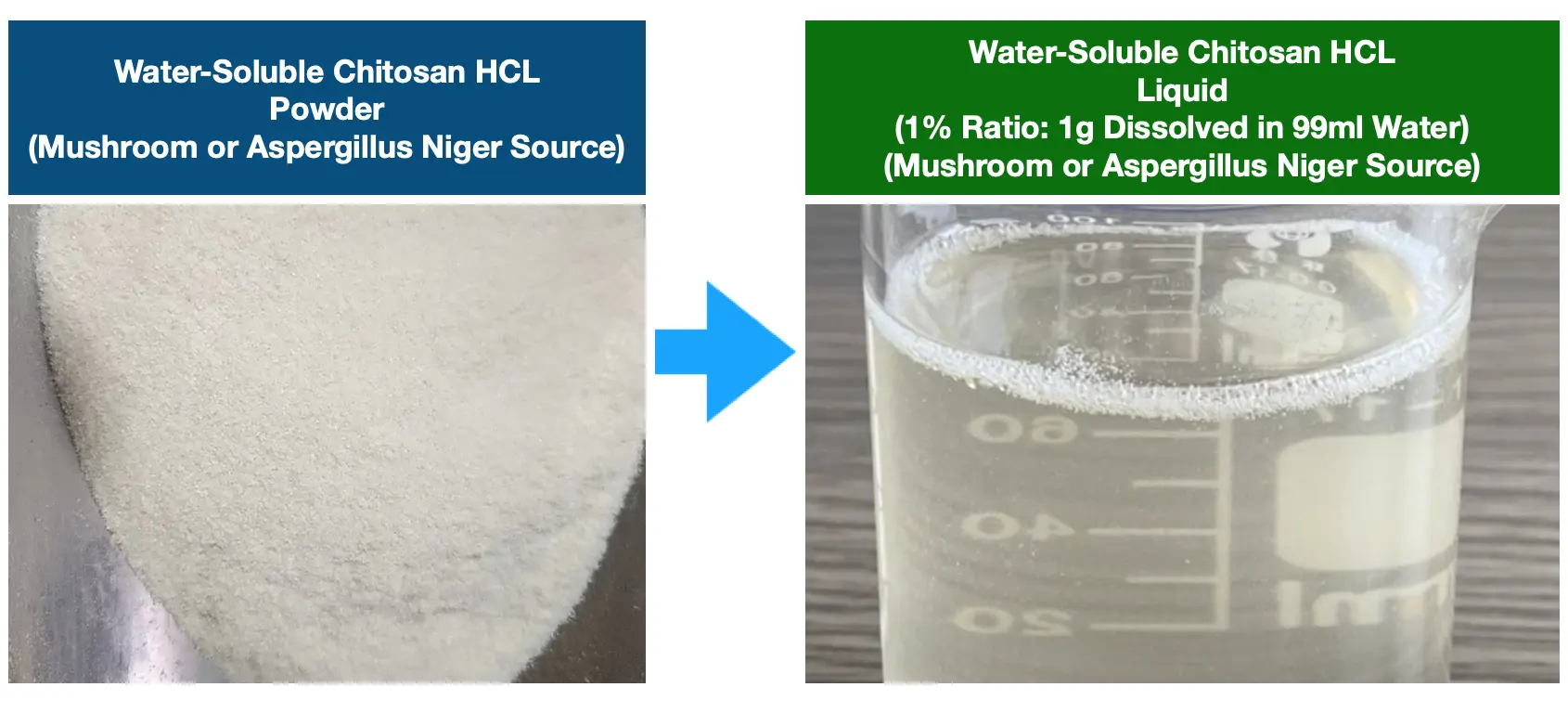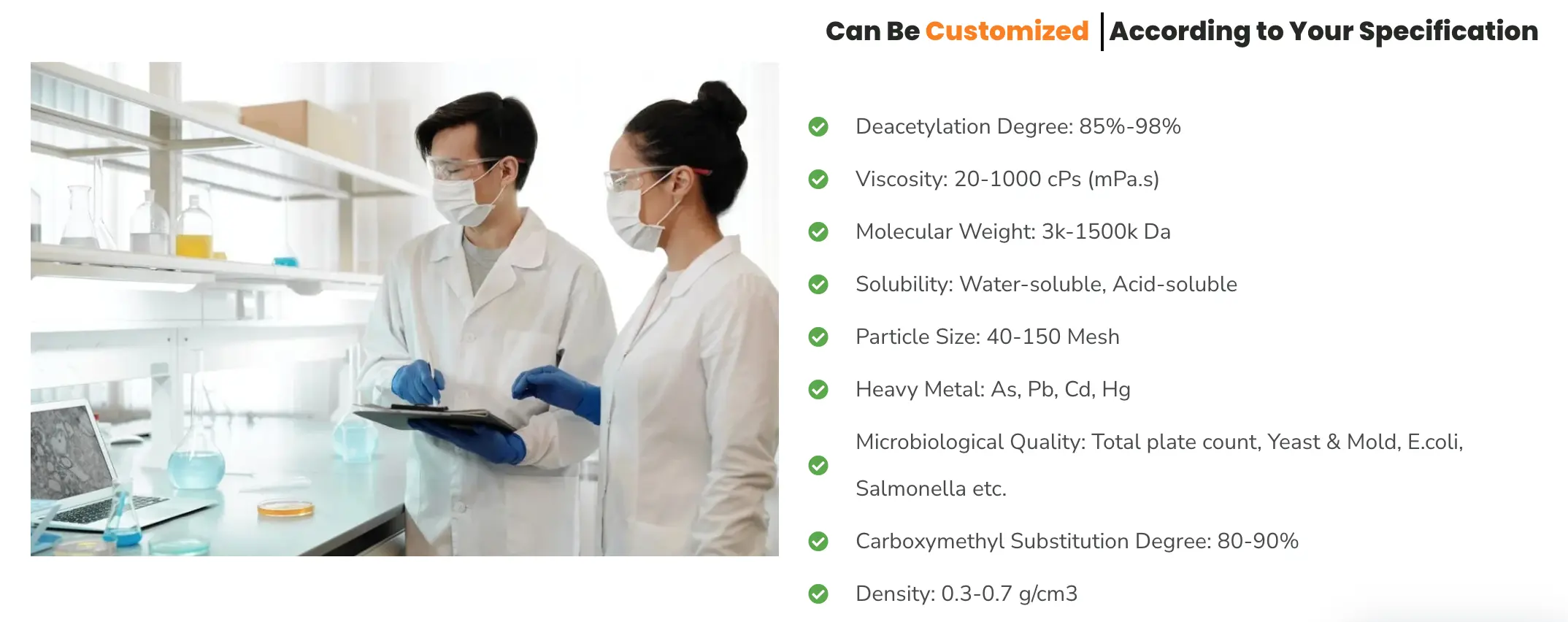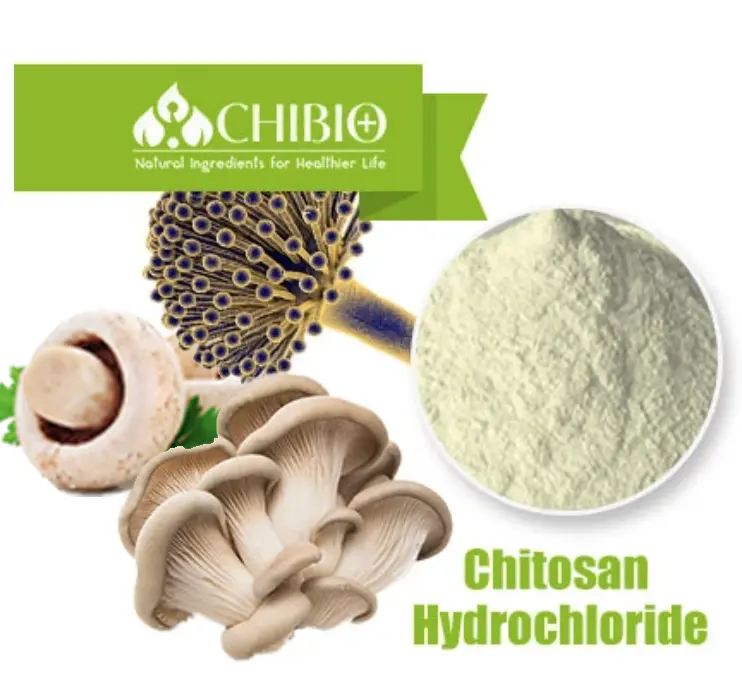Agaricus Bisporus Chitosan Hydrochloride
Agaricus Bisporus Chitosan Hydrochloride
Additional information
| Product Name | Water-soluble Agaricus Bisporus Chitosan Hydrochloride |
|---|---|
| Form | Off-white to light yellow powder |
| Source | Agaricus Bisporus (White Button Mushroom) |
| Cas No. | 70694-72-3 |
| Specification | Water-soluble, viscosity 20-400cps (typical 20cps) |
| Main Applications | Cosmetics (skincare, haircare), Food, Wine, Pharma etc |
Product Details

What is Agaricus Bisporus Chitosan Hydrochloride?
Agaricus Bisporus Chitosan Hydrochloride is a water-soluble, plant-based chitosan derived from Agaricus bisporus (white button mushroom).
This specialized form of chitosan is created through the reaction with hydrochloric acid, resulting in a highly soluble derivative that is particularly suitable for applications in pharmaceuticals, cosmetics, and food products. It offers a sustainable, non-animal alternative to traditional chitosan, making it ideal for vegan and allergy-conscious consumers.
CAS Number:
- CAS No.: 70694-72-3
- CAS No.: 70694-72-3 (for Chitosan Hydrochloride)
Chemical Structure:
- Chemical Formula: (C6H11NO4)n⋅HCl(C_6H_{11}NO_4)_n · HCl(C6H11NO4)n⋅HCl
- The chemical structure of Agaricus Bisporus Chitosan Hydrochloride consists of D-glucosamine units linked by β-(1→4) glycosidic bonds, with hydrochloride groups attached, enhancing its solubility in water.
The repeating unit can be represented as:
- [–(C_8H_{15}NO_5)–NH_2·HCl–]n
Where “n” represents the degree of polymerization.

Specification
- Appearance: Off-white to light yellow powder
- Degree of Deacetylation: ≥ 85% (typically ≥98%)
- Molecular Weight: 20,000 – 580,000 Da
- Viscosity (1% in water): 20-400 mPa.s (customizable) (typically 20cps, 100cps, 200cps, 400cps)
- Moisture Content: ≤ 10%
- Ash Content: ≤ 1.5%
- Solubility: Highly soluble in water
 This table illustrates a direct correlation between the viscosity and molecular weight of chitosan, where higher molecular weights result in increased viscosity.
This table illustrates a direct correlation between the viscosity and molecular weight of chitosan, where higher molecular weights result in increased viscosity.
This relationship is crucial for selecting the appropriate chitosan grade for various applications, as higher viscosity chitosan, due to its larger molecular structure, is ideal for creating thicker gels and films.
Additionally, the degree of deacetylation influences this relationship, further refining the material’s suitability for specific industrial uses.
Solubility
Agaricus Bisporus Chitosan Hydrochloride is specifically designed for excellent solubility in water, with ratio of 1% (1g in 99ml water), making it highly versatile for use in various formulations, particularly where water solubility is essential.

Kindly watch the videos of solubility of different types of vegetal chitosan: https://www.chibiotech.com/video/
Specification Customized Service
We offer tailored solutions to adjust the molecular weight, degree of deacetylation, and other specifications to meet your specific application needs, ensuring optimal performance. Advantages & Benefits
Advantages & Benefits
- High Water Solubility: Easily dissolves in water, making it suitable for a wide range of applications.
- Vegan and Non-Allergenic: Ideal for individuals with shellfish allergies or those following a vegan lifestyle, as it is derived from mushrooms.
- High Purity: Ensures a clean, consistent product free from animal derivatives, suitable for sensitive applications.
- Eco-Friendly: Produced using sustainable practices, contributing to environmental conservation.
 Functions
Functions
- Film Formation: Forms strong, flexible films ideal for coatings, packaging, and drug delivery systems.
- Thickening Agent: Acts as a natural thickener and stabilizer in food, cosmetic, and pharmaceutical products.
- Antimicrobial Properties: Inhibits bacterial and fungal growth, enhancing product safety and longevity.
- Bioactive Carrier: Ideal for delivering active ingredients in pharmaceuticals and cosmetics.
 Main Applications (More about applications)
Main Applications (More about applications)
- Cosmetics: Used in lotions, creams, and gels for its water-soluble, film-forming, and moisturizing properties.
- Food & Beverage: Acts as a natural thickener and stabilizer in water-based products.
- Pharmaceuticals: Key ingredient in drug delivery systems and wound care products due to its water solubility and biocompatibility.
- Wine Fining Agent: Enhances clarity and stability in wine by removing sediments and impurities.
- Dietary Supplements: Offers health benefits as a water-soluble ingredient in various supplement formulations.
Flowchart
The production process of Agaricus Bisporus Chitosan Hydrochloride involves the extraction of chitosan, its reaction with hydrochloric acid, and subsequent purification steps to ensure high solubility and quality. The flowchart of mushroom (oyster mushroom or Agaricus Bisporus) chitosan illustrates the process of producing chitosan and its derivatives from mushroom material. Here’s a summary of the key content:
The flowchart of mushroom (oyster mushroom or Agaricus Bisporus) chitosan illustrates the process of producing chitosan and its derivatives from mushroom material. Here’s a summary of the key content:
- Starting Material: The process begins with mushroom material as the source.
- Filtration: The mushroom material undergoes a filtration process.
- Protein Removal: Proteins are then removed from the filtered material using an alkali solution.
- Ash Removal: Ash content is subsequently removed with acid.
- Chitin Extraction:
- Acid is added without bubbles to proceed to the next stage.
- Chitin is extracted, which is not soluble in acid.
- An acetylation step removes the acetyl groups from the chitin using sodium hydroxide (NaOH), converting it into chitosan, which is soluble in acid.
- Drying: The acid-soluble chitosan is then dried to produce the final mushroom chitosan product, showcased as a white powder.
- Chitosan Derivatives: Parallel to the drying process, there is a branch leading to the production of various chitosan derivatives:
- Chitosan Hydrochloride: Chitosan converted into its hydrochloride form.
- Enzyme Hydrolysis: Produces chitosan oligosaccharide through enzymatic hydrolysis.
- Carboxymethyl Chitosan: Derived through the carboxymethylation of chitosan.
The flowchart depicts a methodical approach to converting mushroom material into various forms of chitosan, focusing on the purification and chemical modification steps necessary to achieve different chitosan-based products for use in various applications.  Here are simplified descriptions of the flowcharts for Chitosan Hydrochloride: Chitosan Hydrochloride Production:
Here are simplified descriptions of the flowcharts for Chitosan Hydrochloride: Chitosan Hydrochloride Production:
- Step 1: Chitosan is mixed with water and hydrochloric acid.
- Step 2: The solution is formed, and natural ethanol is added.
- Step 3: Precipitation occurs, followed by centrifugal separation.
- Step 4: The product is washed, followed by another round of ethanol addition.
- Step 5: The mixture undergoes centrifugal separation, drying, sieving, and final testing.
- Result: Chitosan Hydrochloride.
Why Choose Us? (>>See more about us)
- Proven Expertise: With over 8 years of experience, Chibio Biotech is a leading innovator in the field of vegetal chitosan (oyster mushroom, agaricus bisporus and aspergillus niger sources).
- Global Reach: Trusted by top companies across 50+ countries, we are your reliable partner in delivering high-quality, natural ingredients.
- Certified Quality: Our products meet the highest industry standards, with ISO 22000:2018, Kosher, Halal, and Organic certifications. (>>See more about our certificates)
- Customer-Centric Approach: We offer personalized support, from product development to after-sales service, ensuring your complete satisfaction.
Why your businesses consider using vegetal chitosan?
Using vegetal chitosan in your applications or formulations offers significant benefits to businesses, as outlined below:
- Eco-Friendly and Sustainable: Vegetal chitosan is derived from plant sources such as mushrooms and fungi, making it an environmentally sustainable alternative to traditional animal-based chitosan. This aligns with growing consumer demand for green and eco-friendly products.
- Non-Allergenic and Vegan-Friendly: Unlike crustacean-derived chitosan, vegetal chitosan does not trigger shellfish allergies and is suitable for vegan and vegetarian consumers. This widens the market reach for products formulated with vegetal chitosan.
- Versatility and Superior Functionality: Vegetal chitosan offers excellent biocompatibility, biodegradability, and antimicrobial properties. These attributes enhance its utility across various industries, including food, pharmaceuticals, cosmetics, textiles, and agriculture.
- Enhanced Product Performance: In many applications, vegetal chitosan improves product qualities such as moisture retention, antimicrobial efficacy, and barrier properties. This leads to better-performing end products, such as longer shelf-life for food items or improved durability and functionality in textiles.
- Market Differentiation: Incorporating vegetal chitosan allows companies to differentiate their products by promoting natural, sustainable, and allergen-free claims, which are increasingly valued by health-conscious and environmentally aware consumers.
In summary, using vegetal chitosan can help your businesses enhance their product offerings, meet consumer demands for sustainable and non-allergenic ingredients, and improve your overall market positioning.
Explore the potential of Water-soluble Agaricus Bisporus Chitosan Hydrochloride today! Contact us for more details and to request a custom quote. Let’s work together to bring nature’s best to your products.
Get in touch with us to boost your business

- Get Free Sample
- Get Step Quote
- 24/7 Service
- Customized Specification
- Confidentiality Agreement
Headquarter
Block B, Vanke Center, No.2 Heilongjiang South Road, Shibei District, Qingdao City, China 266033
Phone
+86 (0)532 66983270
Cellphone / WhatsApp / WeChat
+86 156 6577 2296
+86 133 8100 5417




